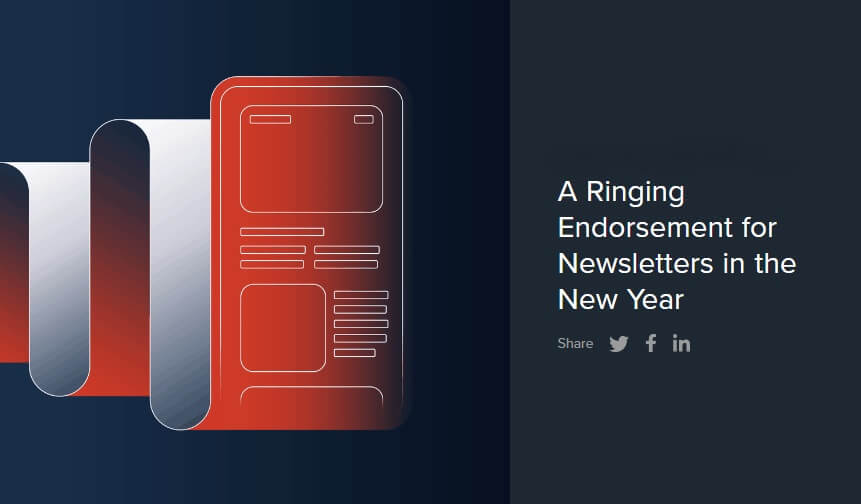For some, the thought of an email newsletter for B2B marketing might seem outdated. Perhaps it’s because they have seen the tremendous changes in social media marketing, like the use of hashtags, stories, highlights, and live videos. Or maybe they simply see newsletters as promotional and boring, or even a waste of time.
But if we’ve learned anything during the pandemic, it’s the need for strong remote selling tools. At one point, we were not allowed to be face-to-face with customers because of shelter-in-place. And then at another point, prospects began to prefer shopping on their own terms and without contacting sales. So, as you continue planning for the new year, why not plan on integrating a newsletter into your B2B marketing mix to consistently stay in front of customers?
The Spire Wire, our agency newsletter, is an important way in which we keep our own clients, prospects, and employees engaged in our agency. It’s filled with news, stories, events, employee profiles, account wins, B2B stats, white papers, and even our #SpireOnSpotify playlists. For at least one day a month, we know our agency becomes a priority for this group as the newsletter hits their inbox. And we know these stories help drive not only agency awareness, but also traffic to our website.
A newsletter is a digital 1:1 meeting with your consumers. It’s personal and intimate, and professional and effective at the same time. Ignoring the potential of a newsletter, or believing they are “old school,” can restrict B2B brands from growth. A newsletter opens the door with news and updates to help further your reach, generate leads, increase user engagement and increase conversions.
That said, you should approach every newsletter with the explicit intention of providing your audience with immediate value. Ideally, your newsletter will motivate your customers to take some form of action, such as:
- Read your latest blog post or news story
- Sign up for an upcoming event
- Check out a new case study
- Visit you at a trade show
- Watch a video
- Learn more about a new product or service
- Take part in a prize drawing, giveaway, or offer
- Buy something from your online store
According to Statista, there are 3.9 billion daily email users, a number expected to climb to 4.3 billion by 2023. What’s even more impressive is that 58% of us start our day by checking email, according to OptinMonster. With 91% of all U.S. consumers still using email daily, newsletters are one of the most efficient ways to put your products in front of your customers.
In fact, according to the Content Marketing Institute, 74% of content marketers say that emails (such as newsletters) are the most successful way of helping their businesses reach their specific conversion goals. They also found that 40% of B2B marketers claim that email newsletters are the most important tactic in their content marketing strategy, and 31% say that sending email newsletters is the best way to nurture leads. And email is 4% better at converting than social media, which is why 4 out of 5 marketers stated they would rather give up social media than email marketing, according to HubSpot.
As with any other email campaign, there are several main email marketing metrics to keep in mind when tracking the success of your newsletter:
- Open rate
- Click-through rate
- Engagement level
- Bounce rate
- Unsubscribe rate
For a newsletter to be effective, marketing and sales need to work together on ensuring a steady stream of news and insights. Without it, brands tend to struggle in generating consistent, impactful content. But when done well, there are five benefits that can result from a successful newsletter initiative.
1. Building Relationships
Simply by signing up for a newsletter, a current customer or prospect is giving you permission to communicate with them regularly, provided your information is of value. This is the beginning of an ongoing relationship that will strengthen with time.
“Signing up is a powerful signal of intent to buy. Send them an email until they do.”
– Jordie van Rijn, Online Marketing Consultant
That’s because newsletters provide a great opportunity to connect with your audience and show that you care. In a report by Salesforce, 84% of customers said that being treated like a person, rather than just a number, was an integral factor in winning their business. This goes to show that connecting with your audience on a personal level shouldn’t just be a bonus, but a necessity for growing your business. An easy and effective way to connect with them consistently with valuable information and not just a sales push.
Readers enjoy receiving real, raw thoughts from a brand or business they love. Done right, using newsletters to connect with your customers can ultimately translate to a more loyal and valued customer base.
2. Establishing Credibility
Using your newsletters to curate news updates, industry insights, and thought-leadership pieces can be a great way to engage your subscribers and add interest beyond your brand or business. By including summaries of news stories and linking out to reputable sources, you can instantly offer information that’s compelling, digestible, and relevant in an easy-to-read, bite-sized format.
To put together a must-read newsletter that captivates your customers every time, make sure you’re creating or curating content that’s relevant to them. Whether it be through instructional content or how-to articles that help them accomplish a goal, listicles that provide them with a collection of tips, trends, or products, or roundups that recap your company’s recent news, accomplishments, or updates, using your newsletter in this way is a great digital marketing tactic to repurpose content that already exists and package it up in a way that’s truly valuable. And done consistently, customers begin to rely on your ongoing content to make them smarter in their business life.
3. Deepening Brand Understanding
Every marketer knows that the key to any successful campaign is a strong and recognizable brand, and a big element of developing a brand is coherent, consistent, and compelling storytelling. Newsletters present the perfect vehicle to share your brand story, add depth to your business, and show your customers who you are and what you stand for. By revealing little snippets about what your brand is all about, what goes on behind the scenes, where you came from and how you came to be, your audience will stop seeing your business as a faceless entity and start paying attention to the real people involved.
“Products are made in the factory, but brands are created in the mind.”
– Walter Landor, Designer and Online Marketing Pioneer
Instead of using your newsletter to push products (you can use targeted ecommerce emails for that), try sharing inspiring customer stories and testimonials, mini profiles on your employees, words of wisdom from your founders or company executives, or even infographics showing business impact. Readers will enjoy the fact that your newsletter is more than just an advertisement for products. And the more they get to know who you really are, the more their loyalty to your business will grow.
4. Sharing of Knowledge
As stated before, one of the best things about newsletters is that they help brands stay in front of customers. But they can also help sales stay in front of customers.
The news, insights, stats, and information found in newsletters all become things your sales force can post on LinkedIn and other business platforms. Sharing these articles with the leads keeps a salesperson top-of-mind with the customer base, but without being too salesy.
More than half (55%) of decision-makers on LinkedIn use thought leadership to determine which organization to work with. What’s more, 20% of investors say that it’s the best platform when you want to learn about a topic. The content of your newsletter becomes a vessel for the sales team to bolster that thought leadership among decision-makers.
5. Generating Sales
We’ve all heard of the 80/20 rule. But for B2B, it’s more of the 95/5 rule, which shows that 95% of your potential buyers aren’t ready to buy today. These 95% are “out-market” today, but will be “in-market” sometime in the future. A newsletter helps you fill that 95% gap, and helps close that 5% sales opportunity.
According to Pagely, emails are said to prompt three times more purchases than social media posts, with their average order value also being 17% higher. A study by Campaign Monitor found that for every $1 that businesses spend on email campaigns, they can potentially see $44 in return. That’s why 80% of professionals say they continue using email marketing because it grows both customer acquisition and retention, according to Insider Intelligence and eMarketer.
“Never forget social media is for reach but email is for revenue.”
– Bryan Eisenberg, Marketing Author
So, how do you get started on publishing your first newsletter in the new year? Many major CRMs (HubSpot, Constant Contact, Mailchimp, and Emma, for example) have pre-made templates to get you started on creating a professional-looking newsletter, no matter what industry or niche you’re targeting. Now all you need is the content and a database of customers. Start with a few stories and perhaps a stat or two in your first newsletter and build from there. Once you have a mindset of finding stories, the content becomes easier to generate and your newsletter becomes even more effective.
Before the ball drops, don’t drop the ball on implementing an effective newsletter program. Newsletters have evolved to be a crucial tactic in a successful B2B marketing plan, and when executed well, they can truly increase your brand presence and boost your sales. As your business weighs which channels to utilize in the new year, we hope we’ve made the case to include newsletters as part of your marketing strategy.
And to stay up to date on Spire news, awards, and blog posts, don’t forget to subscribe to our Spire Wire newsletter.
Mike Stopper is Executive Vice President of Client Service and Planning at Spire and AAF Dallas’ most-awarded account director for the last eight years.
original content










